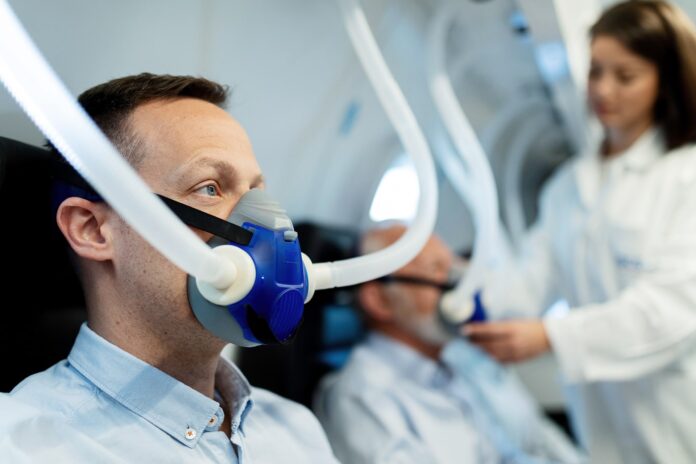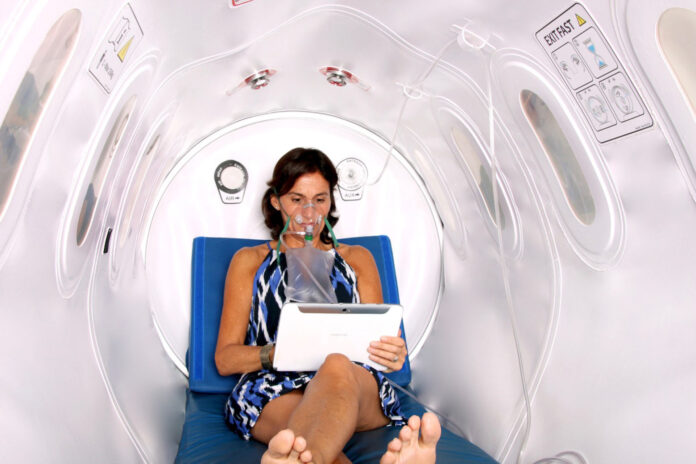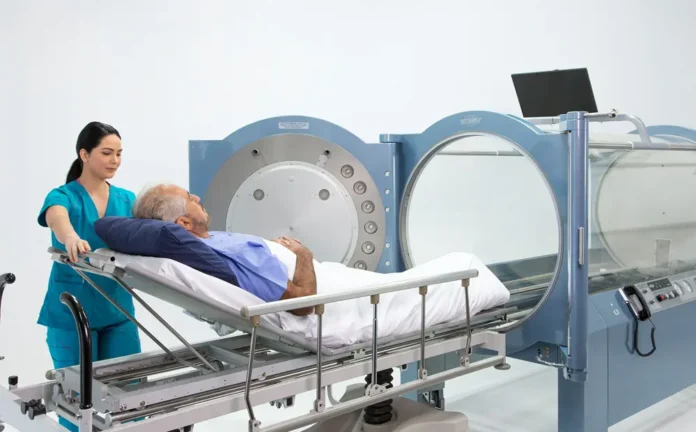Hyperbaric oxygen therapy is all about breathing almost pure oxygen in a pressurized environment. Decompression sickness, a possible risk of scuba diving, is treated properly with hyperbaric oxygen therapy.
The air pressure in a hyperbaric oxygen therapy chamber is two to three times higher than normal air pressure. Under certain conditions, your lungs can absorb far more oxygen than if you were breathing pure oxygen at normal atmospheric pressure. When your blood carries this extra oxygen all across your body, it aids in the fight against bacteria and induces the release of substances known as growth factors and stem cells, both of which boost healing.
Multiplace Hyperbaric Chambers by reliable companies, such as http://oxyhelp.com is designed and built to very strict technological specifications. It has a dual over-pressure safety mechanism and is suitable for home use.

Why Is Hyperbaric Oxygen Therapy Done?
Hyperbaric Oxygen Therapy is done for wounds that occur due to carbon monoxide poisoning and diseases that occur due to oxygen deprivation.
Hyperbaric oxygen therapy (HBOT) is a treatment method used to hasten the recovery of carbon monoxide poisoning, gangrene, non-healing wounds, and infectious diseases in which tissues are oxygen-starved. The Navy used it to treat deep-sea divers suffering from decompression sickness. The therapy was also used to cure carbon monoxide poisoning in the 1960s. It is still used to cure sick scuba divers and people suffering from carbon monoxide poisonings, such as firefighters and miners. It’s also been approved for a number of other conditions, varying from burns to bone disease, also including:
- Poisoning from carbon monoxide
- Poisoning with cyanide
- Acute or traumatic decrease in artery blood flow
- Crush wounds
- Gangrene is caused by gas
- An air or gas bubble that is confined in a blood vessel (air or gas embolism)
- Actinomycosis is a chronic condition.
- Osteomyelitis is a bone infection that does not respond to other treatments.
- Diabetes wounds that are failing to heal
- The disease that consumes flesh
- Radiation harm that is postponed

What Happens During Hyperbaric Oxygen Therapy?
As the therapy starts, you will hear a hissing noise as the chamber starts to pressurize. Throughout this compression, you may recognize a temporary rise in temperature. A specialist will modify the compression rate based on your sensitivity and mentor you on how to relieve the full sensation in your ears. The compression step of the treatment usually lasts about 10-15 minutes and varies depending on how well you clear the pressure in your ears.
The pressure will eventually reduce over a 10-15 minute period following the conclusion of your treatment. As a result of the reduced pressure, you will feel a popping sensation in your ears throughout this decompression. This popping is a standard atmospheric pressure adaptation inside your ears.
How Does Hyperbaric Oxygen Therapy Work?
For such therapy, you enter a special chamber and breathe pure oxygen at 1.5 to 3 times the standard air pressure. The goal is to provide enough oxygen in the blood to restore tissues and reinstate normal body function.
- HBOT helps in recovery of wound by providing oxygen-rich plasma to oxygen-less tissue. Wounds harm the body’s blood vessels, causing fluid to spill into the tissues and resulting in swelling. This swelling prevents injured tissue from oxygen, causing the tissue to die. HBOT minimizes swelling while supplying oxygen to the tissues. The increased pressure in the chamber, the more oxygen there is in the blood. HBOT aims to break the cycle of swelling, oxygen deprivation, and tissue death.
- HBOT blocks the activity of harmful bacteria while also strengthening the body’s immune system. HBOT can fight off Specific bacteria. It also increases the level of oxygen in the tissues. This aids in their resistance to infection. Furthermore, the therapy enhances white blood cell’s means to detect and decimate intruders.
- HBOT prevents “reperfusion injury,” which is extreme tissue harm caused due to blood supply coming back to tissues that have been lacking oxygen. In times when blood flow is interrupted (for example due to a crush accident), a range of events within the damaged cells leads to the emission of harmful oxygen elements. These molecules can cause extreme tissue harm. They result in blood vessels to confine and prevent the flow of blood HBOT helps the body’s oxygen radical eaters to try to get the harming molecules, for their recovery to proceed.

What Are The Advantages Of Hyperbaric Oxygen Therapy?
Numerous people profit from hyperbaric oxygen therapy, particularly those with chronic wounds. Hyperbaric oxygen therapy can aid tissue healing by stimulating new skin, blood vessels, and connective tissue formation. HBOT promotes the development of new collagen and skin cells. It accomplishes this by empowering the formation of new blood vessels. It also encourages the production of certain substances in cells, such as vascular endothelial growth factors. These draw and enhance endothelial cells, which are required for healing.
When Should You Not Use Hyperbaric Oxygen Therapy?
Hyperbaric oxygen therapy chambers are becoming more common in a variety of settings, ranging from outpatient hospital departments to spas. There are even chambers for use at home.
Not everybody is a candidate for hyperbaric oxygen therapy. People who have recently had a cold or fever, even certain types of lung disease, ear surgery or injury, should not use it. Hyperbaric Oxygen Therapy shouldn’t be used for the following conditions:
- asthma
- heart disease
- multiple sclerosis
- sports-related injuries
- depression
- spinal cord injuries
- migraine
- HIV
- hepatitis
- Parkinson’s disease
- cerebral palsy
- strokes
- Bell’s palsy
- brain injuries
- Alzheimer’s disease
- AIDS

Mention The Side Effects Of Hyperbaric Oxygen Therapy
The most common side effect following HBOT is middle ear trauma. These potential complications include eye damage, lung collapse, low blood sugar levels, and sinus problems. Oxygen poisoning can occur in rare and severe cases. This can result in seizures, fluid in the lungs, lung failure, or other complications. Considering the hazards and benefits, the choice to use hyperbaric oxygen therapy should be carefully defined after consulting with your healthcare provider.
Conclusion
The process of breathing nearly pure oxygen in a special room or small chamber is known as hyperbaric oxygen therapy (HBOT). Its primary application is to cure diving-related illnesses, but it may also improve the recovery process in people with a variety of other conditions.
Consult your doctor if you have a chronic wound or another medical condition that could profit from hyperbaric oxygen therapy, such as drastic anemia. Your doctor will assist you in determining whether this method is appropriate for you.





![Calgary’s Hottest Neighborhoods for Luxury Homebuyers [2024]](https://thewashingtonote.com/wp-content/uploads/2024/04/Calgary-324x160.png)



